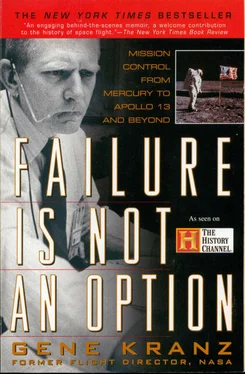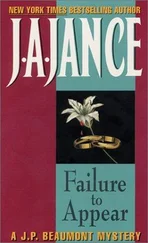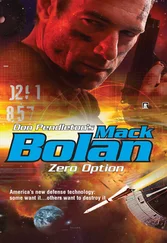Two hours after the wave-off, Griffin had powered down the lunar module. Both spacecraft were now flying in close formation. After reviewing the Apollo 9 test data, Canin moved to Griffin’s console for a private one-on-one. “Gerry, if the problem is in the control circuit,” he said, “I think we can give the Go for the separation and landing. We can electrically drive the engine nozzle into position for the maneuver and then lock it in place with the drive clutch.” Listening in, Kraft interrupted, “That’s not what North American engineers say.” Canin responded, “Let’s get them on the voice loop and go over the test data from Apollo 9.” Griffin, feeling better after Canin’s input, called his team to order, and reset the landing for revolution sixteen. Shortly thereafter, lab testing re-created the problem by cutting the control circuit wires. The designers agreed with Larry Canin’s proposed solution to use the drive clutch to hold the nozzle stable during the burn.
In less than four hours after the alarm, Griffin got everyone marching again. “Okay, Gold Team, settle down,” he said, “the mission is back on. We’re going for the landing at Descartes.”
Ken Mattingly was ecstatic when he got the word along with the revised procedures. Coming from behind the Moon on revolution sixteen, after the maneuver, Mattingly reported, “Casper [CSM] did it this time!” Then he continued in his more customary, casual voice with his standard post-burn report. Happiness reigned in both spacecraft and Mission Control.
Pete Frank took a short shift after landing to get the crew into their sleep period and then handed over to my White Team. With the delay in the landing, my job was to lay out the surface plan, establish team schedules, and anchor the lunar liftoff time.
Because of the delayed landing, my Team’s flight planners quickly reassessed the mission. We had at least two and a half days on the surface, cutting only slightly into our water reserve. With their input I advised the control team to plan for a three-EVA mission, and fixed the lunar liftoff for revolution fifty-two. The final step in the process was to post the schedules for the four control teams. My White Team would do a whifferdill, performing two shifts on the second EVA day to get my team into the cycle for lunar liftoff. Midway in the shift I woke up the LM crew, started the EVA preparation, and then handed over to Pete Frank’s Orange Team for the EVA.
The Lunar Rover, used on the final three lunar missions, added a new dimension to the surface operations. It was a miracle of engineering, a battery-powered version of an off-road sport utility vehicle. The Rover deployed from Bay I of the descent stage by a series of cams, pulleys, and cables, unfolding like a collapsible baby carriage. When the Moon buggy landed, it carried everything the crew needed. Like the gold prospector’s burro, the Rover carried the crew and its equipment to the exploration sites. With wire-mesh wheels, four-wheel steering, television and equipment stowage, it was Young and Duke’s magic carpet.
Surface operations are hard work and the first EVA is the toughest. The high-priority science objectives are taken care of first in case something happens to cut the mission short. There are always glitches; Young and Duke had their share as they plowed through the initial surface operations. Then, to highlight their first EVA, they climbed aboard the Rover for the ride of their lives. Their initial targets were named “Spook,” “Buster,” and “Plum” (small craters used as landmarks by the crew). Young and Duke had learned a great deal about pacing themselves and avoiding exhaustion thanks to the Scott and Irwin debriefing. This imperative to conserve energy had been emphasized by the flight surgeons at every opportunity.
My ascent team, like the pilots in Korea, remained on “strip alert” close to the MCC. Throughout the entire lunar surface stay we were at ease, but cocked and ready to get a team in place to plan and execute a lunar liftoff in less than two hours. If a controller could not get from his home to the MCC in less than thirty minutes he was required to stay in the MCC sleeping quarters. If any problems occurred with either spacecraft it was our job to get into Mission Control, assess the options, and get the crew into lunar orbit.
The first EVA went well. Griffin debriefed the crew, and then I picked up the next shift. I was surprised that Griffin’s handover notes indicated that instructions had come down from the program office’s daily management meeting to shorten the final liftoff by one revolution, and end the mission a day early. My flight planners and the LM backroom team were already in the process of marking up the flight plan and checklists for the early liftoff when I arrived for my shift. I was damn angry and told them to stop doing the mark-ups. I intended to stay with the EVA and liftoff plan we had established on our prior shift.
There had been a rumor circulating after landing that the mission would be limited to two EVAs as a result of the landing delay but I had paid it little attention. Now someone in the management chain was making decisions normally reserved for the flight directors, and the decisions were contrary to the mission rules.
If the mission was cut short, I knew that Young and Duke on the surface and Mattingly in the command module would go for broke to complete every objective. The crew’s drive to get as much done as possible would put us into the kind of exhaustion and resulting physiological problems that we had experienced with Scott and Irwin. I also did not want to compress the preparation for the lunar liftoff. Departing the Moon is one thing that you don’t want to do in a hurry, one of the times when you proceed with deliberate caution.
For the second time in my MCC career, I lost my temper. I turned to Bill Tindall seated behind me at the Flight Operations director console, and asked, “Bill, do you know where this bullshit plan to lift off early came from?” He raised his hands. “I think it came down from today’s program management meeting.” My reply was curt. “Does Kraft know this?” Bill nodded affirmatively. Glancing into the viewing room I saw Chris, Sjoberg, and McDivitt. “Let’s take a walk,” I motioned to Tindall.
This time I was a lot smarter. I sketched out for Kraft the surface plan that led to my selection of the liftoff time. Then citing the crew workload and the Apollo 15 experience, I said that I thought it “unsafe” to press for an earlier liftoff. I used “unsafe” about every fifth word, since I had watched Kraft play the safety card at many meetings and now I decided to steal his trump. I finally put it pretty bluntly: “Chris, why don’t you leave the mission planning to the team? What the hell is the hurry to get off the Moon?”
I studied his face, got the feedback I wanted, and then continued. Turning down the emotion: “A lunar ascent is the time when everything has to go well. I want two hours of data for the controllers and time for the crew to wind down from the EVA and transition to ascent thinking. We’ve had a good mission so far, why push it? This plan increases the risk with no payback.”
I had argued often with Kraft before, but seldom had I ever caught him so far off base, agreeing to a change of plan without hearing the other side. After a brief exchange on keeping a reasonable crew workload, Chris nodded, “So be it.”
Kraft’s heart was still at the console. He was still “Flight” no matter what his position in management, and while the crew medical status was foremost in the minds of every top-level NASA leader, he gave his team the benefit of the doubt. The experience on Apollo 15, especially the lack of specific knowledge of the hour-by-hour crew status, colored our judgment. Neither crew nor controllers had the experience or the data to know how close we were to the edge.
Читать дальше












